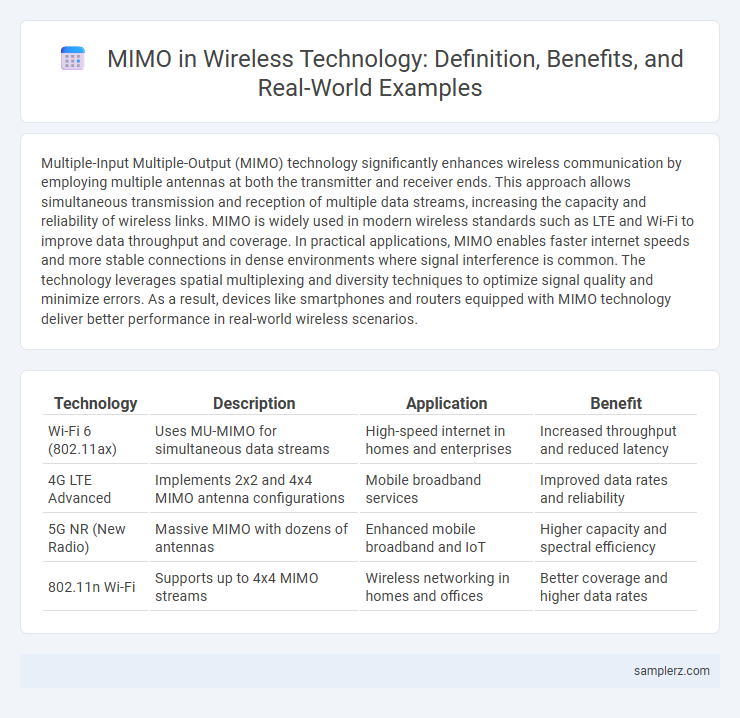Multiple-Input Multiple-Output (MIMO) technology significantly enhances wireless communication by employing multiple antennas at both the transmitter and receiver ends. This approach allows simultaneous transmission and reception of multiple data streams, increasing the capacity and reliability of wireless links. MIMO is widely used in modern wireless standards such as LTE and Wi-Fi to improve data throughput and coverage. In practical applications, MIMO enables faster internet speeds and more stable connections in dense environments where signal interference is common. The technology leverages spatial multiplexing and diversity techniques to optimize signal quality and minimize errors. As a result, devices like smartphones and routers equipped with MIMO technology deliver better performance in real-world wireless scenarios.
Table of Comparison
| Technology | Description | Application | Benefit |
|---|---|---|---|
| Wi-Fi 6 (802.11ax) | Uses MU-MIMO for simultaneous data streams | High-speed internet in homes and enterprises | Increased throughput and reduced latency |
| 4G LTE Advanced | Implements 2x2 and 4x4 MIMO antenna configurations | Mobile broadband services | Improved data rates and reliability |
| 5G NR (New Radio) | Massive MIMO with dozens of antennas | Enhanced mobile broadband and IoT | Higher capacity and spectral efficiency |
| 802.11n Wi-Fi | Supports up to 4x4 MIMO streams | Wireless networking in homes and offices | Better coverage and higher data rates |
Introduction to MIMO Technology in Wireless Communication
Multiple Input Multiple Output (MIMO) technology employs multiple antennas at both the transmitter and receiver ends to enhance wireless communication performance. By exploiting spatial multiplexing and diversity, MIMO significantly increases data throughput and link reliability in standards such as LTE and Wi-Fi 6. This technology enables efficient spectrum utilization and improved signal quality, driving the evolution of high-speed wireless networks.
Real-World Applications of MIMO Systems
MIMO technology enhances wireless communication by using multiple antennas at both the transmitter and receiver to improve data throughput and signal reliability. Real-world applications include 4G LTE and 5G networks, where MIMO enables higher spectral efficiency and better coverage in dense urban environments. Advanced Wi-Fi standards like Wi-Fi 6 also leverage MIMO for faster speeds and reduced interference in crowded wireless settings.
MIMO in 4G LTE Networks
MIMO (Multiple Input Multiple Output) technology in 4G LTE networks significantly enhances data throughput and spectral efficiency by utilizing multiple antennas at both the transmitter and receiver ends. LTE networks implement MIMO configurations such as 2x2, 4x4, and even 8x8 to support high-speed mobile broadband and improve connection reliability. The use of spatial multiplexing and diversity techniques in MIMO enables LTE to achieve faster data rates and better coverage in wireless communication.
Role of MIMO in 5G Wireless Technology
MIMO (Multiple-Input Multiple-Output) technology plays a crucial role in enhancing 5G wireless networks by enabling multiple antennas at both the transmitter and receiver ends, significantly increasing data throughput and spectral efficiency. By leveraging spatial multiplexing and beamforming techniques, MIMO improves signal reliability and coverage in dense urban environments, supporting higher user densities and faster speeds. Massive MIMO, a key 5G innovation, uses large antenna arrays to further optimize network capacity and reduce latency, essential for applications like IoT and real-time communication.
Wi-Fi Routers Utilizing MIMO Technology
Wi-Fi routers utilizing MIMO (Multiple Input Multiple Output) technology enhance wireless communication by employing multiple antennas for simultaneous data transmission and reception, significantly boosting network capacity and throughput. This technology enables higher data rates, improved signal quality, and reduced interference in crowded wireless environments. Advanced Wi-Fi standards such as Wi-Fi 5 (802.11ac) and Wi-Fi 6 (802.11ax) incorporate MIMO to support multiple devices with efficient spatial multiplexing and beamforming capabilities.
MIMO Deployment in Smart Home Devices
MIMO technology in smart home devices enhances wireless connectivity by using multiple antennas to transmit and receive data simultaneously, improving signal strength and coverage. Popular smart home systems, such as Wi-Fi 6 routers and IoT devices, deploy MIMO to support multiple connected devices with higher data rates and reduced latency. This deployment enables seamless streaming, robust home automation, and efficient device communication in densely populated wireless environments.
Advantages of MIMO for IoT Connectivity
MIMO (Multiple Input Multiple Output) technology significantly enhances IoT connectivity by increasing data throughput and network capacity through simultaneous transmission and reception of multiple data signals. It improves signal reliability and coverage, reducing interference and packet loss in dense IoT networks. These advantages enable efficient real-time communication for a vast number of IoT devices, supporting applications like smart cities, industrial automation, and healthcare monitoring.
Case Study: MIMO in Satellite Communication
MIMO technology in satellite communication enhances data throughput and signal reliability by utilizing multiple antennas at both the satellite and ground stations, enabling spatial multiplexing over vast distances. A notable case study involves the deployment of MIMO on High Throughput Satellites (HTS), where beamforming techniques optimize spectrum use and reduce interference in crowded orbital slots. This application significantly improves broadband connectivity in remote regions, demonstrating MIMO's potential to revolutionize global satellite communication networks.
Massive MIMO for Enhanced Mobile Data Rates
Massive MIMO technology significantly boosts mobile data rates by using large arrays of antennas to simultaneously transmit and receive multiple data streams, enhancing spectral efficiency and network capacity. This approach enables better signal quality and coverage in dense urban environments, supporting high user demands and faster wireless connections. Telecom companies leverage Massive MIMO in 5G networks to provide reliable, high-speed mobile broadband services with reduced latency and improved energy efficiency.
Future Trends of MIMO in Wireless Networks
Future trends of MIMO in wireless networks include the development of Massive MIMO technology, which utilizes hundreds of antennas to significantly enhance spectral efficiency and network capacity. Integration of MIMO with millimeter wave (mmWave) frequencies supports ultra-high data rates and low latency for 5G and upcoming 6G networks. Advanced beamforming algorithms and AI-driven signal processing further optimize MIMO performance in dynamic wireless environments.

example of MIMO in wireless Infographic
 samplerz.com
samplerz.com